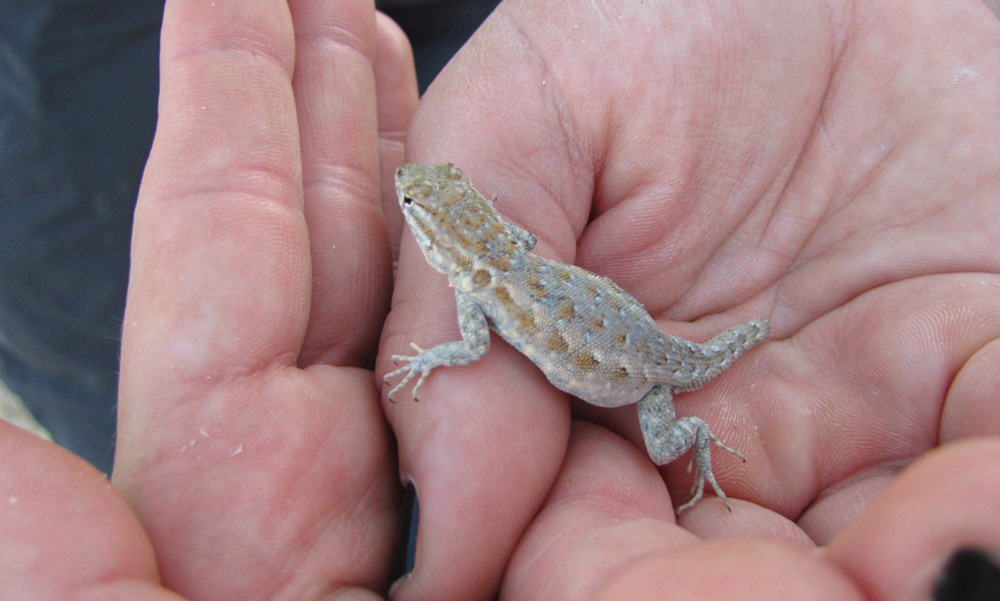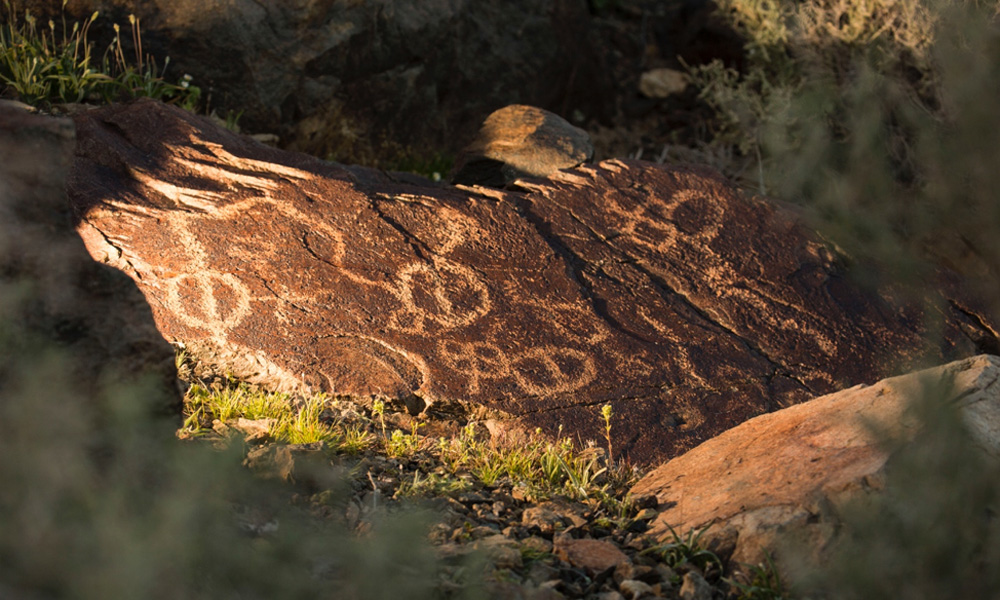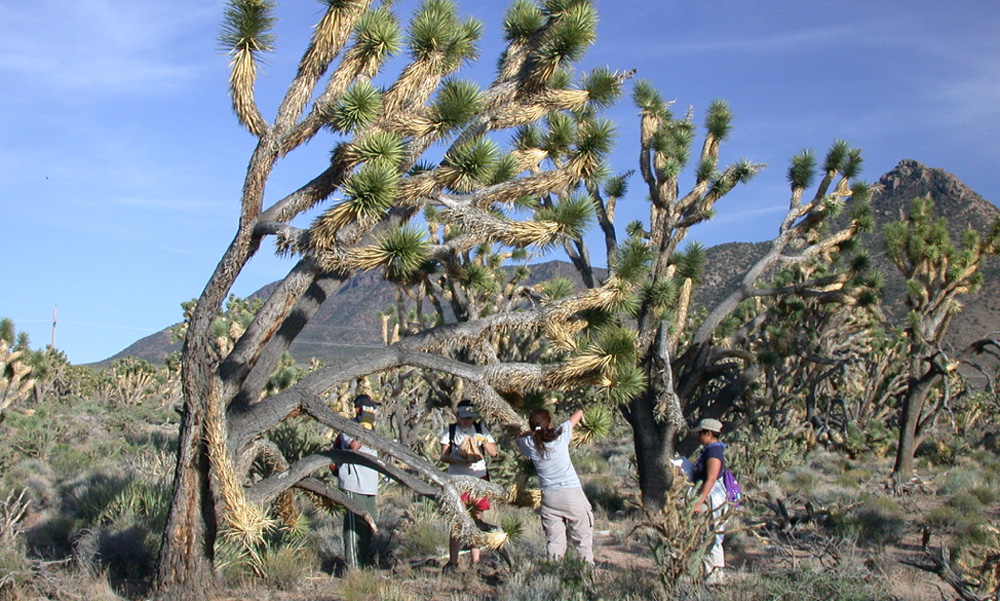The California Desert Studies Consortium (CDSC) is a multicampus consortium committed to advancing education and research opportunities in arid-land ecosystems. The consortium operates the CSU’s Desert Studies Center field station in the Mojave National Preserve, a premier location and resource for studying the geology, anthropology and biology—among many other topic areas— of California’s deserts and the American West.
Identifying Causes of Genetic Diversity using Desert Reptile Populations

In the extreme heat of summer, you may find Dr. Eric Routman, professor of biology at San Francisco State, and his bold students looking for lizards on the rocky slopes near the CSU Desert Studies Center at Zzyzx, California. Dr. Routman’s group is studying desert lizards to help address a long-standing evolutionary puzzle—what factors most strongly contribute to the genetic diversity of a species? Although mathematical models have been quite successful at linking genetic variation to a number of potential evolutionary drivers (drift, selection, gene flow, mutation, recombination), conclusive evidence of these links using natural populations has been far more difficult to attain. Applying traditional DNA sequencing as well as next-generation shotgun sequencing to estimate levels of genetic diversity, Routman and his students have shown that some desert reptile species possess extraordinary levels of genetic variation while others have much less, despite being found in the same desert location. The various species also differ in population sizes, potential for gene flow, generation time and other factors that are predicted to affect genetic diversity. By comparing these factors for species that are closely related and found in the same location, these desert reptile studies provide better control for variation in mutation rates and population histories than typical comparisons made across a broader taxonomic range.
Transdisciplinary Studies Provide Keys to Connecting Climate, Ancient Desert Lakes and People of the Past

On the shores of ancient Lake Mojave (today’s Soda and Silver Lake playas), Dr. Edward Knell, professor of anthropology at California State University, Fullerton, and Dr. Matthew Kirby, professor of geological sciences at California State University, Fullerton, have undertaken a transdisciplinary, long-term research program to better understand the linkages between past human lifeways and changes in past climate. The Desert Studies Center (DSC) has served as a base for this research since 2009. Transdisciplinary research collaborations focused on Lake Mojave began in earnest in the 1930s and continue today. Much like previous researchers who sought to date the shorelines and place the many archaeological sites in chronological context, Dr. Knell and Dr. Kirby have combined the efforts of archaeologists, geologists and students to address similar and more nuanced research goals, but now with the advantage of newer methods and technologies.
Kirby and his geology students focus on paleolimnology, or the study of past climates from lake sediments, to improve our understanding of Lake Mojave’s shorelines, including the chronology, extent of wetland habitat and changes in past climate. These interests dovetail nicely with Knell’s research on determining how past peoples adjusted their lifeways to meet changes in climate—changes that affected the availability of food resources, how people moved across the landscape and where people settled or conducted their activities along the lake margins. Together, one of the biggest questions the Knell/Kirby collaboration is addressing is how chronological changes in lake level influenced the extent and placement of wetlands and the potential plant and animal foods available for humans. Understanding these responses will help determine how such changes affected the way Paleoindians (possibly as early as the end of the last ice age) and later groups moved to and around pluvial Lake Mojave and the playa lakes that followed (i.e., Silver and Soda Lake playas).
Some of the latest geological findings are the product of climate reconstruction from a recently acquired lake sediment core. Kirby and colleagues (including undergraduate and graduate co-authors) reconstructed 14,800 years of lake history, inferring a more complex late glacial-through-Holocene lake history than previously known. Moreover, their results suggest a strong 14,800-year coupling between Pacific Ocean-atmosphere processes and winter precipitation over the Silver Lake drainage basin. Comparisons to other regional paleoclimatic archives reveal a consistent spatial pattern of Holocene climate change in the southwestern United States, including Southern California. Perhaps most striking is evidence for a sustained, millennial-scale period of aridity in the mid-Holocene.
Knell’s research began in 2009 with field seasons each summer through 2017 that resulted in the systematic pedestrian (walking) survey and in-field analysis of nearly 5,000 stone artifacts from 6.5 square miles of shoreline along Soda and Silver Lake playas. At two bedrock quarries, his team determined how stones from fine-grained volcanic outcrops were reduced at the quarry sites and then transported to shoreline sites for further modifications. Furthermore, by making geochemical links between the stone artifacts and specific quarry sources, he determined that people arrived at Lake Mojave primarily from the northwest, where obsidian from the Coso volcanic field (about 175 km to the northwest) and Goldstone dacite (about 70 km to 80 km to the northwest) are found. Others came from directly north, from the Shoshone Mountain obsidian source (about 140 km).
Knell and Kirby’s teams consistently include graduate and undergraduate students from Cal State Fullerton and other CSU and state university schools. Participants have used their experiences to produce anthropology master’s theses as well as geology master’s and bachelor’s theses. While stationed at the Desert Studies Center for fieldwork, students not only gain important hands-on experience in their field of science, they also understand how their science links to the many past and present natural and cultural phenomena around the center. This transdisciplinary archaeology and geology research helps students make these important connections, which has made the DSC an invaluable aspect of their joint research program.
Understanding Conflict in a Mutalistic Relationship - Joshua Tree and their Yucca Moth Pollinators

With support from the Judith A. Presch Desert Research Scholarship, Albert Dang and his master’s thesis adviser—Dr. Jeremy Yoder, assistant professor of biology at California State University, Northridge—have used the Desert Studies Center as a base to study one of the most iconic Mojave Desert plant species, the Joshua tree (Yucca brevifolia) and its pollinators. Yucca moths deliver pollen to fertilize yucca flowers after laying eggs in them so that their larvae can feed on developing yucca seeds. This creates an evolutionary conflict because selection should favor moths that lay as many eggs as possible in a single flower and put as little effort as possible into collecting and delivering pollen—while selection in the host plant should minimize the number of seeds lost to moth larvae. Dang and Dr. Yoder’s research will lead to a better understanding of how this conflict is resolved so that the yucca moths’ interests (the laying of many eggs) best align with their hosts plants’ interests (the receiving of lots of high-quality, diverse pollen). They will use genetic analysis of the Joshua tree seeds from throughout the range of the species to see whether fruits that received more diverse pollen contain more seeds and also support more moth larvae. In other words, to find out whether moths that provide better pollination service might be rewarded with higher seed availability for their offspring.
Dang exemplifies the value of programs like Desert Studies and places like the Desert Studies Center — where unique experiences may lead to an otherwise unrecognized career path. Dang grew up in the Bay Area, the son of immigrants. He is among the first generation of his family to attend college. At San Francisco State, he discovered a fascination with insect diversity, which he pursued in a summer field course in Ecuador and volunteer work at the Essig Museum of Entomology at University of California, Berkeley. He came to CSUN to pursue research on the yucca-yucca moth mutualism with Yoder.